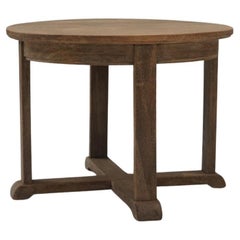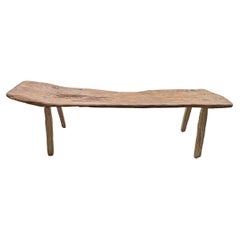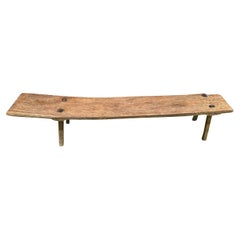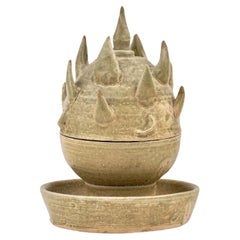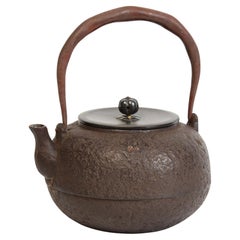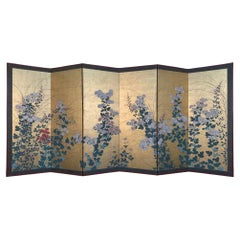Asia - Asian Art and Furniture
Early 20th Century Japanese Taisho Asia - Asian Art and Furniture
Wood
Mid-20th Century Indonesian Other Asia - Asian Art and Furniture
Wood, Teak
Mid-20th Century Indonesian Other Asia - Asian Art and Furniture
Wood, Teak
15th Century and Earlier Hong Kong Han Antique Asia - Asian Art and Furniture
Stoneware
19th Century Japanese Antique Asia - Asian Art and Furniture
Bronze, Iron
Early 19th Century Japanese Edo Antique Asia - Asian Art and Furniture
Gold Leaf
15th Century and Earlier Chinese Antique Asia - Asian Art and Furniture
Pottery
15th Century and Earlier Vietnamese Antique Asia - Asian Art and Furniture
Stoneware
Late 20th Century Indonesian Other Asia - Asian Art and Furniture
Yarn
15th Century and Earlier Vietnamese Antique Asia - Asian Art and Furniture
Ceramic, Porcelain
15th Century and Earlier Hong Kong Ming Antique Asia - Asian Art and Furniture
Pottery
17th Century British Georgian Antique Asia - Asian Art and Furniture
Canvas, Linen, Wood
Early 20th Century Chinese Other Asia - Asian Art and Furniture
Ceramic, Pottery
1720s Vietnamese Qing Antique Asia - Asian Art and Furniture
Ceramic
18th Century Burmese Antique Asia - Asian Art and Furniture
Wood
1920s Japanese Japonisme Vintage Asia - Asian Art and Furniture
Silk, Wood
15th Century and Earlier Hong Kong Han Antique Asia - Asian Art and Furniture
Earthenware
15th Century and Earlier Vietnamese Antique Asia - Asian Art and Furniture
Ceramic
15th Century and Earlier Chinese Antique Asia - Asian Art and Furniture
Pottery
Early 20th Century Japanese Taisho Asia - Asian Art and Furniture
Wood
Mid-20th Century Japanese Asia - Asian Art and Furniture
Wood
Late 20th Century Japanese Showa Asia - Asian Art and Furniture
Tin
Late 19th Century Japanese Meiji Antique Asia - Asian Art and Furniture
Wood
15th Century and Earlier Hong Kong Han Antique Asia - Asian Art and Furniture
Earthenware
2010s North Korean Modern Asia - Asian Art and Furniture
Natural Fiber, Plastic, Acrylic, Paper
16th Century Hong Kong Ming Antique Asia - Asian Art and Furniture
Pottery
2010s North Korean Modern Asia - Asian Art and Furniture
Natural Fiber, Plastic, Acrylic, Paper
1920s Japanese Japonisme Vintage Asia - Asian Art and Furniture
Silver Leaf
15th Century and Earlier Hong Kong Ming Antique Asia - Asian Art and Furniture
Pottery
19th Century Chinese Qing Antique Asia - Asian Art and Furniture
Brass, Bronze
19th Century Japanese Antique Asia - Asian Art and Furniture
Paper
Early 20th Century Taisho Asia - Asian Art and Furniture
Wood
Early 20th Century Indonesian Other Asia - Asian Art and Furniture
Wood, Teak
1720s Vietnamese Qing Antique Asia - Asian Art and Furniture
Ceramic
Early 20th Century Japanese Japonisme Asia - Asian Art and Furniture
Gold Leaf
Early 20th Century Japanese Asia - Asian Art and Furniture
Wood
Early 20th Century Japanese Asia - Asian Art and Furniture
Bamboo
Early 20th Century Japanese Taisho Asia - Asian Art and Furniture
Wood, Cherry
19th Century Japanese Antique Asia - Asian Art and Furniture
Pottery
15th Century and Earlier Thai Antique Asia - Asian Art and Furniture
Pottery
Mid-20th Century Japanese Asia - Asian Art and Furniture
Wood
19th Century Hong Kong Qing Antique Asia - Asian Art and Furniture
Ceramic
15th Century and Earlier Hong Kong Antique Asia - Asian Art and Furniture
Bronze
19th Century Egyptian Egyptian Antique Asia - Asian Art and Furniture
Silver, Copper
1970s Japanese Japonisme Vintage Asia - Asian Art and Furniture
Silver Leaf
Mid-20th Century Japanese Showa Asia - Asian Art and Furniture
Wood
1720s Vietnamese Qing Antique Asia - Asian Art and Furniture
Ceramic
15th Century and Earlier Hong Kong Han Antique Asia - Asian Art and Furniture
Pottery
18th Century Japanese Edo Antique Asia - Asian Art and Furniture
Paper
16th Century Burmese Antique Asia - Asian Art and Furniture
Wood
1720s Vietnamese Qing Antique Asia - Asian Art and Furniture
Ceramic, Porcelain
15th Century and Earlier Hong Kong Ming Antique Asia - Asian Art and Furniture
Pottery
Early 20th Century Taisho Asia - Asian Art and Furniture
Wood
18th Century Burmese Antique Asia - Asian Art and Furniture
Wood
15th Century and Earlier Chinese Antique Asia - Asian Art and Furniture
Pottery
Early 20th Century Japanese Taisho Asia - Asian Art and Furniture
Wood
20th Century Japanese Asia - Asian Art and Furniture
Iron
Early 19th Century Japanese Edo Antique Asia - Asian Art and Furniture
Gold Leaf
19th Century Japanese Edo Antique Asia - Asian Art and Furniture
Wood
19th Century Japanese Antique Asia - Asian Art and Furniture
Cedar, Wood
Read More
Symbols of Happiness and Rebirth Adorn This Japanese Satsuma Bowl
Decorated with white cranes and the sought-after thousand-butterflies motif, the Meiji-period vessel offers both a celebration of traditional aesthetics and a clear reflection of the era’s appetite for exquisite export pieces.
Chicago’s Pagoda Red Has a Spirited Mix of Asian Antiques and Bold New Art
For 25 years, gallerist Betsy Nathan has leveraged her keen eye and key connections to bring a unique selection of rare finds to the market.
In L.A., Gallerist JF Chen Has Long Championed Eclectic Blue-Chip Design
Now working alongside his daughter Bianca, dealer Joel Chen has presented a most covetable array of antiques, art and contemporary creations for more than 40 years.
12 Calming Spaces Inspired by Japanese Design
From cherry-blossom-adorned walls paired with glamorous lighting to wood-paneled ceilings above checkerboard-patterned chairs, these 12 spaces seamlessly blend Eastern and Western aesthetics.
Rodrigo Rivero Lake’s Mexico City Showroom Is a Museum-Worthy Trove of Spanish Colonial and Asian Antiques
The dealer and curator has spent the past 50 years amassing a collection of exceptional art, furniture and architectural elements that trace the cultural influence of the Spanish empire from Europe to the Americas and beyond.
16 Refined Asian-Inspired Interiors
These spaces exemplify how Eastern elements elevate a home's decor.
